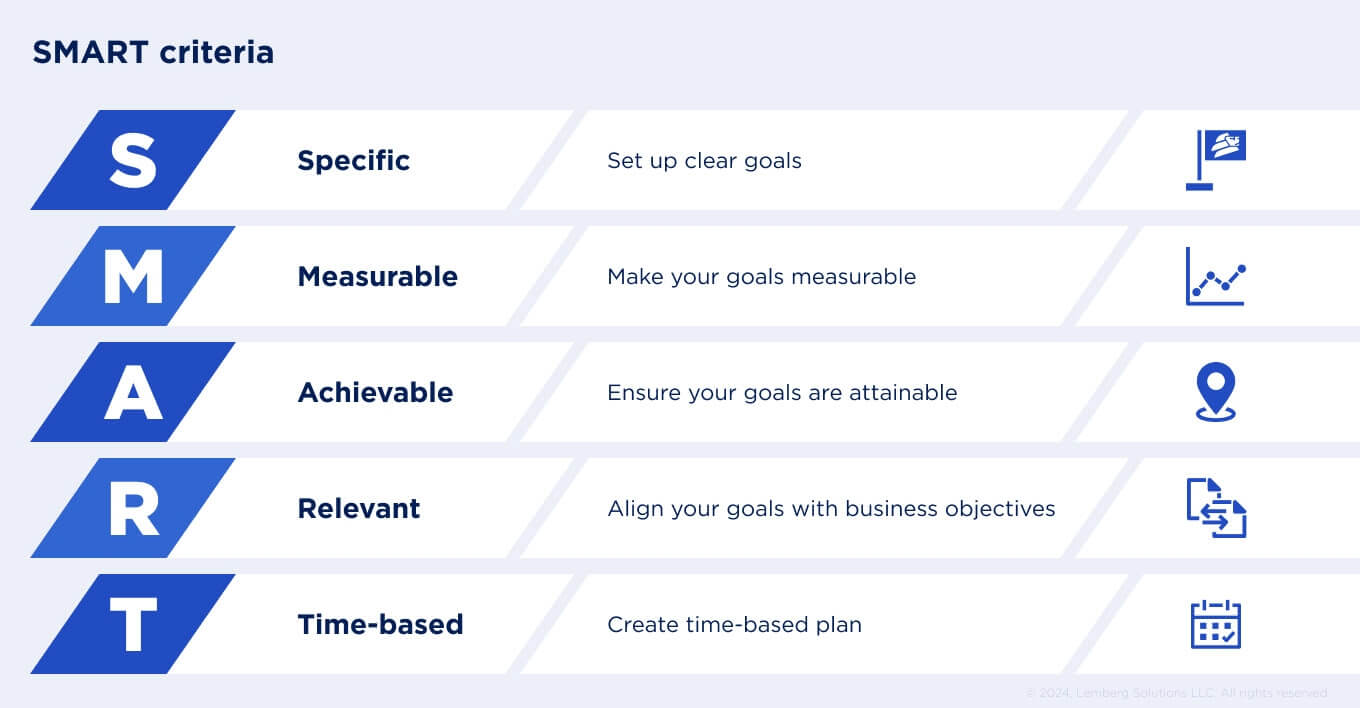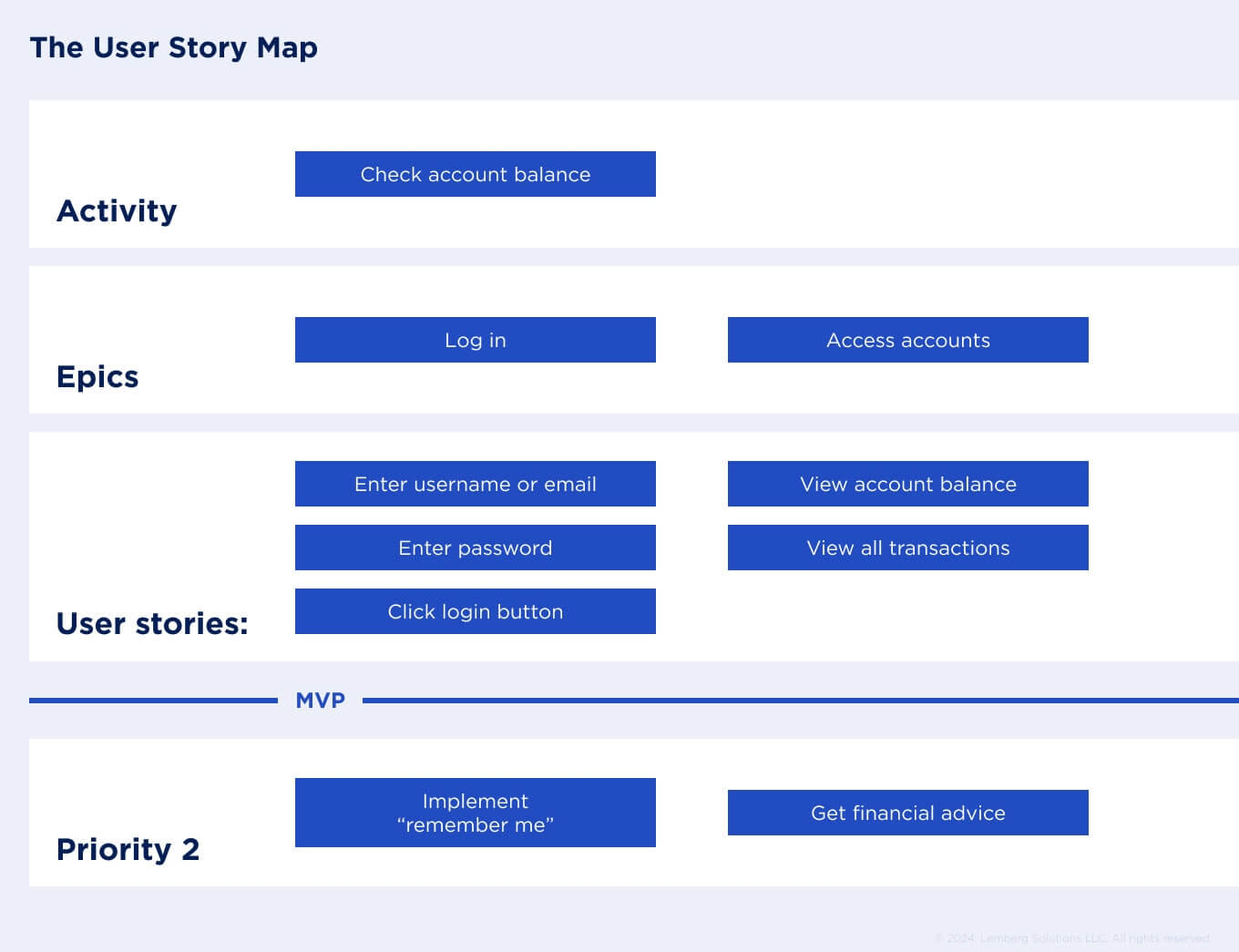Facebook, Dropbox, WhatsApp, and Uber have become leaders in their retrospective niches, transforming the market with their products. However, what unites them? They all started as MVPs, later growing into well-established, mature products. All these success stories began with specific reasons behind them: tackling an issue, finding new ways to optimize inefficient operations, or providing a unique customer experience.
To minimize the risks of failure, developing an MVP first is the best approach to verifying your business idea and accelerating time to market. We want to share the best practices on how to define MVP scope in just four steps. So keep reading for more insights.

What is an MVP?
MVP stands for minimum viable product, the primary version of a product with a set of crucial features. At the same time, all “nice to have” capabilities should be left out of MVP and postponed to later product versions. The main aim of an MVP is to validate the business idea and improve the product’s functionality based on real users’ feedback.
Apart from MVP, other “minimum product” types can be handy for your idea:
- MMP (minimum marketable product) is a product with crucial features that is ready to be sold and enter the market.
- MLP (minimum lovable product) is a minimum product usually built on top of the MVP. Synonyms of MLP are MDP (minimum delightful product) and MAP (minimum awesome product). The core concept of those is to create a positive user experience and let the product become viral.
It does not matter which “minimum product” concept you choose, you’ll anyways need to decide what to prioritize while defining MVP.
How to define your MVP scope in 4 steps
Composing an MVP is a complex process that requires a detailed analysis. Check out our tried and true techniques and standard practices that will help you define your minimum viable product in 4 steps:
Step 1. Determine business goals and objectives
The development of new products is initiated with business goals in mind: maximizing profit, optimizing business processes inside the company, increasing customer satisfaction, or transforming the market with revolutionary ideas. Business objectives help identify the outcomes your organization will achieve after adopting an initiative. Here’s a small hint you can use while outlining business objectives — follow the SMART principle, which states that objectives should be specific, measurable, achievable, relevant, and time-based.

Business objectives are the base of the MVP scope. For instance, your business objective is to launch a product to the market in one year and make it commercial within two years. Understanding your time framework can help you set a clear roadmap, identifying which features you can implement during a certain timeframe. This means that your first MVP project does not need to include all possible features, as you can add them later, keeping your focus on the core functionality that corresponds to your business goals and objectives.
Step 2. Get to know your users
Before proceeding to the development process, you should learn who your customers and users are. Users and customers can be the same group of people, but often that’s not the case. Frequently, business owners focus only on customers — key stakeholders who will purchase the product or service, while ignoring users' demands, people who will directly use the product. Thus, you need to listen to the users’ needs in the first place to ensure high product adoption, which in turn, can increase business revenue.
To define your users, start with an individual or group brainstorming session with your team. When you come up with as many ideas as possible, you can group and prioritize them. After defining your main user groups, analyze them, trying to answer such questions:
- What are your users’ occupations, interests, and demands?
- Which problems and challenges do they face?
- What do they like and dislike?
Ideally, to gather the most precise answers, you need to conduct interviews with potential users. However, if you don’t have a chance to do so, you can operate with assumptions, which you can verify after the launch of the MVP project.
Step 3. Match user needs with your product features
Users could have plenty of needs, and it is nearly impossible to meet all of them. So the most paramount thing to do is to choose those user needs that are aligned with your business goals. Another critical factor is to prioritize the users’ needs and ways of solving them according to the available resources. At this stage, you should create a Business Objective Model. This will allow you to match every problem with a business objective and a possible solution. As a result, you will have a high-level product concept with key MVP features listed.

Step 4. Prioritize scope
When you have a high-level list of features based on user needs and your business objectives, it’s time to visualize the scope of MVP before prioritization. User story map is proven to be quite helpful for this. Your user story map can consist of several levels, where you can outline user steps, more extensive features (epics) of the product, and the details of the features (user stories). It is common to put the most important features at the top, and those not included in the MVP scope can be placed at the bottom, divided from the main scope by the horizontal line.

During the scope prioritization, you should consider the following factors:
- Business value and the feature size
It is a common practice to develop the most valuable and the smallest tasks first. You can use a Weighted Shortest Job First technique to assess the priority of initiatives to maximize development efficiency. Also, don’t forget to agree on a relative score for work estimation with the development team; for example, you can use the Fibonacci sequence (1, 2, 3, 5, 8, 13, 21, 34, etc.) for such purposes. This way, you can assign each task a number from a sequence representing its size and complexity. To define each feature's score, you could use any decision-making technique, for example, the Delphi method or Multivoting.
- Risks
If, in your scope, there is a feature crucial for your business, but at the same time so complex that it is hard to assess the possibility of its implementation, you may want to evaluate it at the beginning of the project. Otherwise, you have a risk investing in other less important features when the core functionality is still not implemented. On the other hand, if the feature involves high risks and brings no value to your business, it makes sense to remove it out of the scope completely.
- Dependencies
Dependencies are crucial when creating a schedule for an MVP project with a clear order of tasks. There are two main types of dependencies — technical and logical. Technical dependencies affect the sequence of features’ development. For example, a team can’t start doing their chunk of work when they depend on the tech component that has low priority in the backlog of another team.
Also, there is a logical dependency, meaning that each feature of the software relies on the other to function logically. For example, you implemented a subscription feature to your product; however, the majority of your content is free to access. In this case, the subscription feature needs to be revised because it does not provide benefits for subscription users and does not generate income.
Key reasons to define the scope of MVP functionalities
Over 90% of startups fail to survive on the market. And while this may happen for many different reasons, the main one is poor product-market fit. With a defined MVP scope, you can build the test product to verify your business idea and understand whether it fits the real market needs. After this, you can see whether there is a point to scale your MVP project into a more mature product. A clearly defined MVP scope can bring you such benefits as:
- Faster development time
A well-defined MVP scope with a set of essential features can significantly accelerate development time, resulting in a faster launch to market.
- Decreased upfront costs
Focusing only on “must-have” features and putting aside those that are “nice to have” can profoundly minimize expenses and help you allocate your resources more efficiently.
- Better risk management
Clear MVP scope mitigates the risk of feature creep and establishes transparent goals, helping the development team and key stakeholders avoid miscommunication and stay aligned.
Main points to address when outlining MVP scope
As mentioned before, the main focus of MVP scope is outlining the functionality of the product based on users’ needs. However, apart from that, other significant details must be covered in your scope to manage the development process more effectively. Here are some of them:
- Timeline
As the main purpose of an MVP is to launch the product quickly, you should set clear and realistic deadlines for developing each feature. You should assess the workload with the development team to find the optimal way to implement the MVP scope.
- Team
While outlining the MVP scope, consider the number of team members needed for the MVP project. You can hire in-house developers or find a reliable outsourcing software development company that will handle MVP implementation from scoping to launch.
- Solution architecture and tech stack
Approach the selection of the appropriate tech stack and architecture thoroughly, as they should align with your business goals and system requirements. Reliable tech consulting providers can choose the most suitable technologies specifically for your case to ensure flawless performance and the possibility to scale the product without any problems in the future.
- Deliverables
To assess the development process's progress, it is a good idea to specify measurable deliverables for each sprint. This way, everyone on the team will better understand their task and focus on finding the best possible solution within the defined time and budget limits.
- Security measures and compliance
Even though MVP is not a final product, that doesn’t mean you should neglect its security. Be sure to specify industry-proven security standards to provide robust information security measures to protect users’ data.
Conclusion
MVP scoping may appear challenging, but it is a proven way to mitigate the risks associated with product delivery and user acceptance. The best way to define an MVP scope functionality is to delegate this task to reliable tech professionals who will build an end-to-end delivery roadmap for you.
We provide a solution discovery service during which we go through all the steps from validating business goals to setting up architecture, selecting appropriate tech stack, composing the roadmap, and designing wireframes based on priorities and dependencies. We have successful cases of MVP development of electronic nurse device and Android automotive OS app.
Contact us to access the team of true experts with over 15 years of experience who know how to grow your MVP project into a full-featured product.

